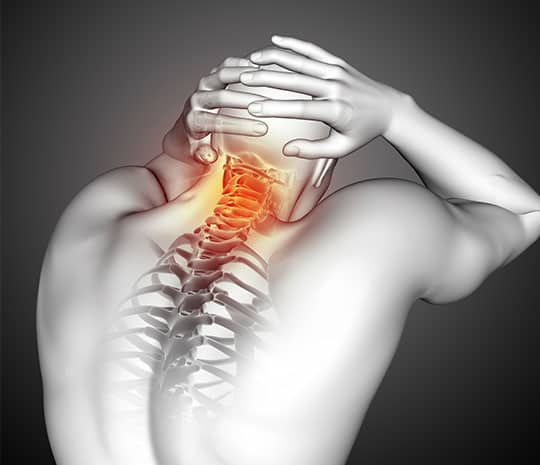Spinal Cord Injury Attorneys
Spinal cord injuries are among the worst medical problems you can face. A damaged spinal cord will often lead to long-term health complications, costly medical treatments, and a reduced quality of life. This can leave entire families in challenging financial and emotional situations that last a lifetime.
If you or a loved one was involved in an accident and suffered a spinal cord injury, you may have grounds to file a lawsuit and receive compensation for your injuries and losses. If language assistance is needed, our team includes a Spanish-speaking lawyer that can help you and your loved ones with your legal needs.
Call now for a free consultation:

What are the types of spinal cord injuries?
Your spinal cord is a bundle of nerves that runs down the middle of your back. Its job is to allow your brain to communicate with your body. A spinal cord injury occurs when some form of trauma damages the backbone and disrupts the communication signals between brain and body.
There are three main types of spinal cord injuries:
- Complete spinal cord injury. A complete injury occurs when your spinal cord is damaged so severely that it loses the ability to send signals below the point of injury. This results in full paralysis below the injury.
- Incomplete spinal cord injury. An incomplete injury occurs when the spinal cord is significantly damaged but is still able to send some signals below the point of injury. This results in limited movement and sensation below the injury.
- Spinal concussion. A spinal concussion is a milder form of spine injury, with symptoms very similar to either a complete or incomplete spinal cord injury. They generally resolve within 24 to 72 hours without leaving permanent complications.
There are two types of paralysis caused by a spinal cord injury:
- Paraplegia. Paraplegia occurs when someone suffers a spinal cord injury and loses feeling and mobility in the lower parts of their body. Affected body parts may include the chest, stomach, hips, legs, and feet.
- Tetraplegia, or quadriplegia. Tetraplegia occurs when someone suffers a spinal cord injury and loses feeling and mobility throughout all or most of their body. Affected body parts may include the head, neck, shoulders, arms, hands, upper chest, pelvic organs, and legs.
Do spine injuries heal?
Injuries to the spinal cord won’t “heal” in the normal sense of the word. This is because the nerve cells in the brain and spinal cord are unable to regenerate or repair themselves in the way cells throughout the rest of our body can. As a result, spinal cord injuries often lead to other lifelong health problems, such as trouble breathing and low blood pressure.
Although rehabilitation and proper care may help individuals with less-severe spinal injuries recover some function, recovery can take months or even years. And progress isn’t guaranteed. Scientists continue to research spinal cord injuries in hopes of discovering more effective recovery methods. But with the current treatment methods, the average settlement for a spinal cord injury needs to be enough to provide lifelong care and assistance.

Symptoms of Spinal Cord Injuries
Symptoms will vary depending on where the spinal injury occurred and how bad it is, but some common spinal cord injury symptoms include:
- Loss of movement anywhere in the body. Inability to move one or several parts of the body, such as arms or legs.
- Altered ability to feel physical sensations. Lost or impaired sensation, including the ability to feel cold, heat, and touch.
- Severe back pain and pressure in your neck. Extreme pain or an intense burning sensation in the back, along with stiffness or pressure in the neck.
- Loss of bladder or bowel control. Inability to control bladder and/or bowel movements.
- Breathing complications. Difficulty breathing, coughing, or clearing lungs.
- Circulatory problems. Low or unstable blood pressure, increased blood clotting, or abnormal heart rhythms (arrhythmias).
- Muscle weakness or spasticity. Decreased muscle strength or tight, stiff muscles that spasm involuntarily.
- Digestive issues. Constipation, abdominal pain or distention, or decreased appetite.
- Sexual dysfunction. Reduced fertility, difficulty becoming aroused, or inability to reach orgasm.
If you’re experiencing any of these symptoms after a spinal cord injury, it’s important that you seek medical attention right away. The sooner you start receiving treatment, the better your chances are of recovering some of your lost function.
The Common Causes of Spinal Cord Injury
There are an estimated 291,000 individuals currently living with a spinal cord injury in the United States, with roughly 17,730 new cases being reported each year. Men are much more likely to be affected by a spinal cord injury, making up about 78% of these new cases annually. Additionally, as of 2019, the average age at injury is 43 years old.
The majority of spinal cord injuries are caused by physical trauma resulting from:
- Motor vehicle accidents. Automobile, motorcycle, and other vehicular accidents are the leading cause of spinal cord injury, accounting for 39% of total cases each year.
- Slip-and-falls. Slip-and-fall accidents and other types of falls are responsible for 32% of spinal injuries annually and are most likely to affect people over the age of 65.
- Acts of violence. Violent encounters, which generally involve gunshot or knife wounds, cause 13.5% of spinal cord injury cases every year.
- Sports and recreational activities. Sports and other athletic activities account for 8% of spinal injuries annually.
Although it’s much less common, there can also be nontraumatic causes of spinal cord injury, such as:
- Medical or surgical complications. Errors that occur during medical or surgical procedures cause 5% of spinal injuries each year. These injuries are sometimes avoidable, meaning that the error could end up being a case of medical malpractice.
- Cardiac arrest. If the heart isn’t pumping blood, it may restrict blood supply to the spinal cord and increase the risk of injury to the spine.
- Spinal tumors. Cancer can be either spread to or formed within the spinal cord. In both cases, it’s possible that the tumor will compress the cord and cause a spinal injury.
- Tuberculosis. Tuberculosis (TB) is an infectious disease that mainly affects your lungs. But if left untreated, the disease can begin to attack the tissue surrounding your spine, causing compression and increasing risk of spinal cord injury.
Back and Neck Injuries at Work
Many workers suffer spinal cord injuries while on the job. For example, if your current position requires you to drive frequently, work near water or other slip hazards, or exert yourself physically, you’re at an increased risk of sustaining a back or spinal cord injury.
If you’ve injured your spine in the workplace, you should contact the spinal cord injury lawyers at McIntyre Law as soon as possible. We can review your case and see if you’re eligible to file a personal injury lawsuit.

Working with McIntyre Law
Spinal cord injuries can lead to severe and costly long-term health issues, which make spinal cord injury lawsuits particularly difficult. They’re high-stakes cases and often involve specialized knowledge, complicated evidence, and complex legal issues that other personal injury lawsuits don’t.
If you’re considering filing a spinal injury lawsuit, getting help from McIntyre Law can simplify the process. Our highly experienced legal team will review your case, gather evidence, and fight to get you the compensation you deserve.
What is a contingency fee?
At McIntyre Law, we operate on a contingency fee basis. This means that we agree to accept a fixed percentage of any monetary rewards from your spinal injury lawsuit to cover our legal fees. If there are no rewards from your case, you don’t owe us anything. We only get paid once you do.
Meet Our Spinal Cord Injury Attorneys Attorneys
At McIntyre Law, we know how difficult spine injuries can be on you and your family. But you’re not alone. McIntyre’s team of top lawyers won’t rest until you receive a fair settlement for your spinal cord injury.

Noble McIntyre

Jeremy Thurman

Jordan Klingler

Monica Schweighart

Brenda Gómez O’Dell

Sarah Ramsey

Mario D’Angelo, Esq.

Daniel Zonas
Can you get compensated for your spinal injury?
If you win your spinal cord injury lawsuit, you could receive compensation for:
- Medical expenses
- Pain and suffering
- Lost wages
- Loss of earning capacity
- In-home assistance
- Loss of companionship
Being such challenging and complicated cases, there tend to be higher average settlements for spinal cord injury lawsuits. With the help of an experienced lawyer, plaintiffs could recover damages in the millions of dollars from their cases.
Types of Spinal Cord Injury Lawsuits
In order to build a case for your spinal cord injury lawsuit, you must be able to prove the cause of your suffering. Generally, injuries of this kind are caused by one of two things: someone else’s negligence or the use of a defective product.
- Spinal cord injuries resulting from negligence. As with most personal injury cases, spinal cord injury lawsuits are often based on negligence. For example, if a tractor-trailer drove through a red light and collided with your car, that would be an instance of negligence. In these kinds of cases, you’ll be required to prove that the defendant is responsible, or “at fault,” for the damages you sustained.
- Spinal cord injuries resulting from defective products. If your injury was caused by a defective product, such as brakes in your vehicle that failed to respond or a spinal cord stimulator that caused paraplegia, you can hold the designers and manufacturers of the product accountable. In product liability lawsuits, you’re eligible to receive compensation as long as you can prove that the defective product was the direct cause of your injury.
Types of Personal Injury Legal Defenses
Knowing how the defendant may combat your claims in court will allow you to build a stronger, more thorough case. Some common legal defenses used in spinal injury cases are:
- Denial of injury. If you fail to see a doctor and document your spinal cord injury following your accident, the defense may argue that the accident wasn’t the cause of the injury. They may argue that the injury was present before the accident occurred, or that the injury resulting from the accident was minor until you did something to make it worse, like going to the gym. Your employer could also use this defense tactic if you fail to document your spinal cord injury after a work-related incident. This example illustrates the importance of gathering evidence and getting treatment directly after you get hurt.
- Contributory and comparative negligence. If the defense claims contributory negligence, they’ll likely argue that your own carelessness contributed to the accident and that they should not be held legally responsible for your injuries. For example, if your injury occurred at work and you were found to be under the influence of drugs or alcohol at the time, your employer could argue contributory negligence. In the case of comparative negligence, the defense will try to prove that both parties are at fault for the injury and that the costs of the damages should be split between them.
- Assumption of risk. Let’s say that you were engaged in a high-risk activity, such as skydiving or white-water rafting, when you sustained your injury. In this case, the defendant will likely argue that you knew (or should have known) the risks associated with the activity and decided to do it anyway, making you responsible for any injuries that occurred as a result. An employer may also choose to use assumption of risk as a defense if your job entails potentially dangerous duties.

5 tips for winning your spinal cord injury lawsuit
Following these steps can help ensure you get the compensation you deserve from your spinal injury lawsuit:

